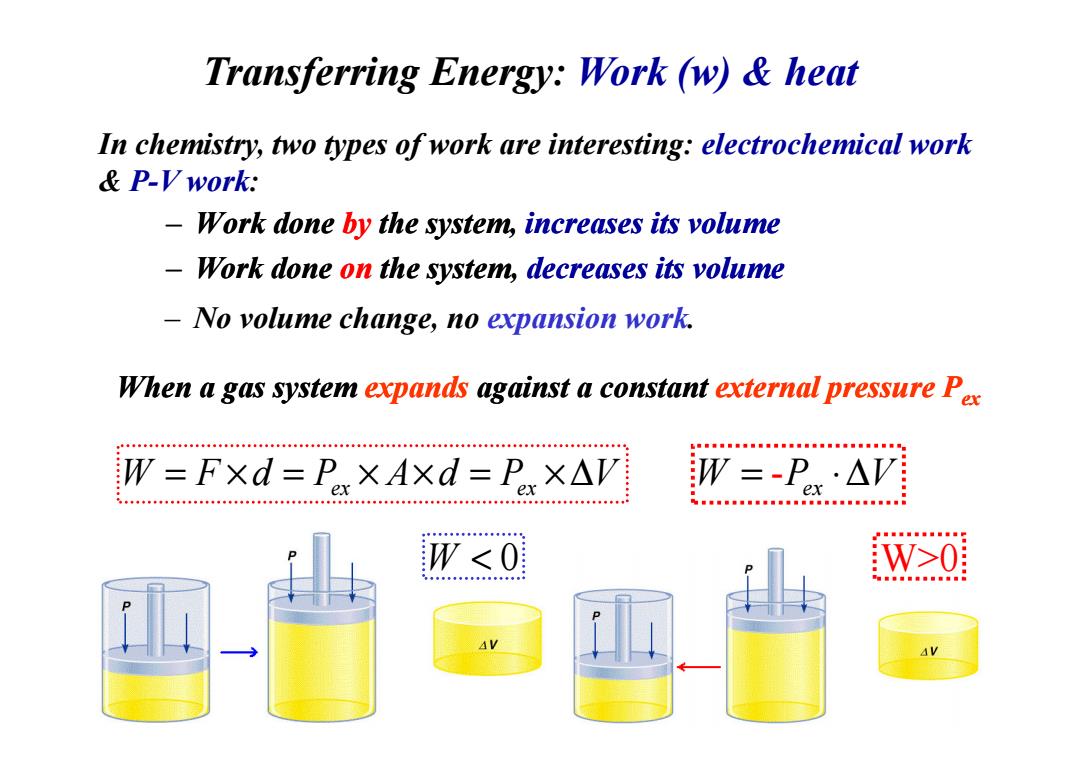
Chap.5 The First Law of Thermodynamics热力学 The internal energy (E)of an system:the sum of the all kinetic and potential energies of all its components. AEsystem十△Fsounding =0 Closed Heat,q surroundings System Work,w △E =-△E system surrounding =9+w Process Sign Work done by the system on the surroundings Work done on the system by the surroundings Heat absorbed by the system from the surroundings(endothermic process) Heat absorbed by the surroundings from the system(exothermic process)
surroundings Closed System Heat, q Work, w Chap.5 The First Law of Thermodynamics ∆ ∆ = E + E 0 system surrounding The internal energy (E) of an system: the sum of the all kinetic and potential energies of all its components. 热力学 E = - E system surrounding ∆ ∆ = +q w

Transferring Energy:Work (w)&heat In chemistry,two types of work are interesting:electrochemical work P-Vwork: Work done by the system,increases its volume - Work done on the system,decreases its volume No volume change,no expansion work. When a gas system expands against a constant external pressure Pe W=FXd=P×AXd=P.X△V W=-Px·△V g W<0 :W>0: AV
– Work done by the system, increases its volume In chemistry, two types of work are interesting: electrochemical work & P-V work: Transferring Energy: Work (w) & heat When a gas system expands against a constant external pressure P – Work done on the system, decreases its volume – No volume change, no expansion work. W F d P A d P V = × = × × = × ∆ ex ex When a gas system expands against a constant external pressure Pex - W P V = ⋅∆ ex W < 0 W>0

Transferring Energy:Work (w)&Heat (q) Exercise 1:What is the change in energy when a system does 135 J work and absorbs 45.0 cal of heat from surrounding? w=-135J q=+45.0cal×4.184J/cal=+188J △E=w+q=-135+188=+53J 1 J=1 kg.m2/s2 Traditional: 1 cal 4.184 J calorie (cal) 1 Cal (big Cal)=1000 cal=1 kcal Nutrition/Food=Calorie(big Cal)
Exercise 1: What is the change in energy when a system does 135 J work and absorbs 45.0 cal of heat from surrounding? w = 1- 35 J ∆E = w + q = 135 188 = - + +53 J q = + 45.0 4.1 cal J/ca × 84 = l J +188 E = system ∆ +q w Transferring Energy: Work (w) & Heat (q) Traditional: 1 cal = 4.184 J ‘calorie (cal) 1 Cal (big Cal) = 1000 cal = 1 kcal Nutrition/Food = Calorie (big Cal) ∆E = w + q = 135 188 = - + +53 J 2 2 1 =1 J kg m⋅ / s

Enthalpy焓 H=enthalpy or “Total Heat Content"” Enthalpy (H):used to quantify the heat flow into or out of a system in a process that occurs at constant pressure (qp). H:a state function.No need to calculate H (absolute value)itself, Only difference in H (AH)is necessary. exothermic -H reactants =9p △H<0 H △H>0 reactants endothermic Activated Activated complex complex K3ou [enualod E Hreactants K3Jou enusiod Hproducts Hproduets Hreactants Reaction progress Reaction progress
∆ = = H q H - H products rea t c ants p Enthalpy H: a state function. No need to calculate H (absolute value) itself, Only difference in H (∆H) is necessary. Enthalpy (H) : used to quantify the heat flow into or out of a system in a process that occurs at constant pressure (qp). H = enthalpy or “Total Heat Content” exothermic 焓 H < H 0 produc st reactants ∆ < H H > H 0 products reactants ∆ > H endothermic

State Function 状态函数 State function:A property of a system,which is independent of the “path”,however,it is dependent only of the“current state” 目前状态 AE-Erinal state-Einitial stateH-H final state-Hinitial state △P=Pfinal state Pinitial state AV-Vrinal state -Vinitial state △T=Tfinal state~ Tintia Potential energy of hiker 1 and hiker 2 is the same even though they took different paths
State function: A property of a system, which is independent of the “path” , however, it is dependent only of the “current state” ∆E= E - E final state initial state ∆P = P - P final state initial state ∆V = V - V final state initial state ∆T = T - T State Function 状态函数 目前状态 ∆H= H - H final state initial state Potential energy of hiker 1 and hiker 2 is the same even though they took different paths. final state initial state ∆T = T - T